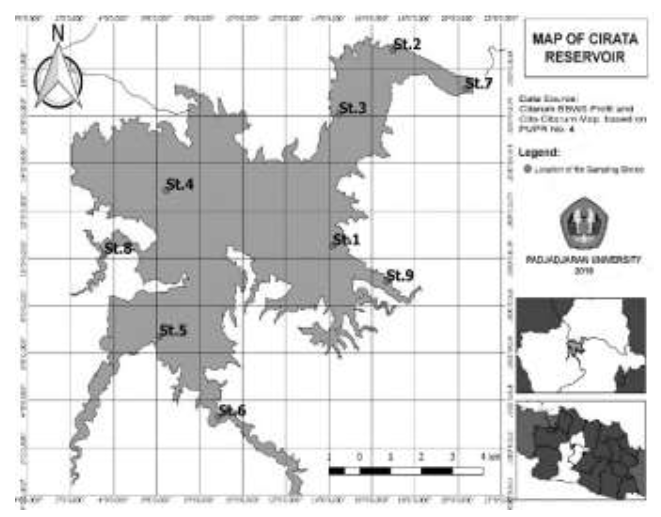The Dynamic of Blue-Green Algae (Cyanobacteria) in Eutrophic Tropical Waters, The Cirata Reservoir
DOI:
https://doi.org/10.51264/inajl.v1i1.4Keywords:
Water Quality, Cyanobacteria, Abundance, Cirata ReservoirAbstract
The quality of reservoir waters depends on changes in their physical, chemical, and biological components. Changes in these parameters lead to the emerging of many problems in the reservoir, such as eutrophication and changes in the composition of the phytoplankton community in the reservoir ecosystem. This eutrophication impact can trigger an explosion of dangerous phytoplankton population, such as blue-green algae (Cyanobacteria). Research on the relationship between water quality and the community structure of Cyanobacteria has been carried out. This study used secondary data from the water monitoring report of the Cirata Reservoir from 2013-2017. This study aimed to obtain information on the community structure of Cyanobacteria and environmental parameters that affected the abundance of Cyanobacteria in the reservoir. Species abundance, diversity index, and dominance index were analyzed to determine changes in the community structure of Cyanobacteria in each of the years. Cyanobacteria abundances were classified using cluster analysis. Water quality parameters such as temperature, transparency, pH, carbon dioxide, nitrate, nitrite, and zooplankton abundance as independent variables, and levels of Cyanobacteria abundances as the dependent variable was analyzed using discriminant analysis. This study showed that the abundance of Cyanobacteria in the Cirata Reservoir is dominated by the Stanieria (a genus of the Pleurocapsales order) every year and the parameter that significantly affects the level of Cyanobacteria abundance was nitrate (NO3-N).
References
Basmi J. 1999. Planktonologi: Plankton sebagai Bioindikator Kualitas Perairan. Fakultas Perikanan dan Ilmu Kelautan IPB, Bogor, Indonesia.
Fahrur M, Makmur, and Rachmansyah. 2012. Dinamika kualitas air dan hubungan kelimpahan plankton dengan kualitas air di tambak kecamatan Bontoa, kabupaten Maros. Prosiding Indoaqua-Forum Inovasi Teknologi Akuakultur, 881-894.
Hulot FD & Huisman J. 2004. Allelopathic interaction between phytoplankton species: the roles of heterotrophic bacteria and mixing intensity. Limnology and Oceanography, 49, 1424-1434.
Kartini T & Permana S. 2016. Analisis operasional Waduk IR. H. Djuanda. Jurnal Kalibrasi Sekolah Tinggi Teknologi Garut, 14(1).
Kim, Hocheol., Bok Yeon Jo, and Han Soon Kim. 2019. Effect of different concentrations and ratios of ammonium, nitrate, and phosphate on the growth of the blue-green alga (cyanobacterium) Microcystis aeruginosa isolated from the Nakdong River, Korea. Algae, 32(4), 275-284.
Masithah ED. 2011. Upaya menurunkan dominansi Microcystis aeruginosa menggunakan enzim pektinase dar Pseudomonas pesudomalle. Berkala Penelitian Hayati Edisi Khusus C, 4, 83-86.
Mur LR, Olav MS, and Hans U. 1999. Cyanobacteria in the environment. Toxic Cyanobacteria in Water: A Guide to their public health consequences, WHO. Chapter 2. https://www.who.int/water_sanitation_health/publications/toxicyanobact/en/
Novia F. 2016. Potensi beban pencemaran nitrogen dari inlet sungai ke Waduk Cirata, Jawa Barat. Seminar Nasional Sains dan Teknologi Lingkungan II.
Odum EP. 1996. Dasar-dasar Ekologi. Edisi 3, Gadjah Mada University Press, Yogyakarta, Indonesia.
PT. LAPI ITB. 2017. Pemantauan Kualitas Air Waduk Cirata Tri Wulan IV Tahun 2017, ITB, Bandung, Indonesia.
Satya A, Sulawesty F, Harimawan A, and Setiadi T. 2018. Correlation of Aquatic Parameters to the Cadmium Bioaccumulation Capability onto Microalgae Biomass in an Urban Lake. Journal of Water Sustainability, 8(2), 59-72.
Sulastri., Henny C, and Nomosatryo S. 2019. Keanekaragaman fitoplankton dan status trofik Perairan Maninjau di Sumatera Barat, Indonesia. Prosiding Seminar Nasional Masyarakat Biodiversitas Indonesia, 5(1), 242-250.
Sunardi, Rina F, Budi I, and Mutia SS. 2017. The dynamic of phytoplankton community structure in face of a warming climate in a tropical man-made lake. Biosintifika, 9(1), 140-147.
Tarunamulia, Kamariah, and Akhmad M. 2016. Keterkaitan spasial kualitas lingkungan dan keberadaan fitoplankton berpotensi HABs pada tambak ekstensif di kecamatan Losar kabupaten Cirebon, Jawa Barat. Jurnal Riset Akuakultur, 11(2), 181-195.
Wijaya HK. 2009. Komunitas Perifiton dan Fitoplankton serta Parameter Fisika-Kimia Perairan sebagai Penentu Kualitas Air di Bagian Hulu Sungai Cisadane, Jawa Barat, IPB, Bogor, Indonesia.







